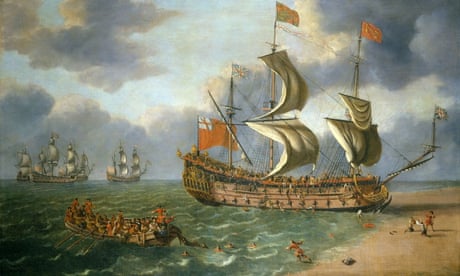The remains of a 17th-century royal shipwreck will go on display in Norwich as part of an exhibition exploring its last voyage. The Gloucester sank off the Norfolk coast in 1682 while carrying the future king of England, Scotland and Ireland, James Stuart, then the Duke of York. The royal passenger was saved, but as many as 250 people drowned.
Artefacts rescued from the wreck will be displayed for the first time, including wine bottles, a urine flask, spoons, the mouthpiece of a brass trumpet, parts of a woman’s shoe, combs, clay pipes, a leather pouch and the ship’s bell. The exhibition, at Norwich Castle museum, also features underwater footage filmed last summer by the divers and brothers Julian and Lincoln Barnwell. The ship is split down the keel and the remains of the hull are submerged in sand, but items including an anchor, rope and cannon are visible in the film, along with glass bottles.
Also visible are fishing nets that have been lost over the years, which the team says highlights the vulnerability of the site. A painting of the 1682 disaster by Johan Danckerts. Photograph: Royal Museums Greenwich/Reuters The exhibition also features work by Garry Momber and Brandon Mason, of the Maritime Archaeology Trust, who conducted photogrammetry of the wreck to produce a 3D model, which will give visitors a diver’s-eye interactive tour of the site.
Momber describes the wreck as the “most significant” they have ever dived. After running aground on a sandbank on 6 May 1682, the Gloucester’s whereabouts remained unknown until it was found in 2007 by the Barnwells and their friend, the retired ex-Royal Navy submariner and diver James Little. The ship’s identity was confirmed in 2012 and its discovery was made public in June 2022.
Lincoln said: “We’re delighted to be able to share these glimpses of the wreck site, more of which visitors will be able to see in the exhibition, and excited to share the rescued artefacts for the first time with the public. Julian added: “The discovery of the Gloucester has been an incredible adventure for all three of us, and we feel very honoured that its story is being told in such a professional and detailed manner. “We are confident that anyone who visits the exhibition will come away with a better understanding of the events of 6 May 1682, and not only their historical and political impacts, but also the human impact on the individuals involved.
” skip past newsletter promotion Sign up to First Edition Free daily newsletter Archie Bland and Nimo Omer take you through the top stories and what they mean, free every weekday morning Privacy Notice: Newsletters may contain info about charities, online ads, and content funded by outside parties. For more information see our Privacy Policy . We use Google reCaptcha to protect our website and the Google Privacy Policy and Terms of Service apply.
after newsletter promotion The academic partner in the Gloucester shipwreck project is the University of East Anglia, with the research being led by maritime history experts Prof Claire Jowitt and Dr Benjamin Redding. Jowitt said: “Until now, only a handful of people have been able to see what the Gloucester wreck site looks like. This footage, together with the artefacts and ongoing historical research, will help underline the importance of Britain’s maritime heritage to our island story.
” She added: “We truly believe this is Norfolk’s Mary Rose. ” The project team are in the process of forming a new charity, The Gloucester 1682 Charitable Trust. They plan to explore the possibility of a permanent museum in the coastal town of Great Yarmouth.
The Last Voyage of the Gloucester: Norfolk’s Royal Shipwreck, 1682 runs from Saturday 25 February to Sunday 10 September 2023, at Norwich Castle Museum & Art Gallery.

